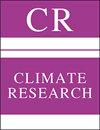Climate change impacts and adaptation strategies on rainfed and irrigated maize in the agro-pastoral ecotone of Northwestern China
IF 1.6
4区 地球科学
Q4 ENVIRONMENTAL SCIENCES
引用次数: 1
Abstract
The agro-pastoral ecotone of Northwestern China (APENC) is one of the major agricultural production areas in China and a region where climate change is evident. Maize is a widely cultivated crop in the APENC, but the potential impact of climate change on maize, and potential adaptation strategies in response to this, are poorly understood. In this study, we used the Cropping System Model (CSM)-CERES-Maize to evaluate the impacts of climate change on maize yield, as well as the feasibility of 2 adaptation strategies; namely, adjusting the planting date and supplying irrigation. CSM-CERES-Maize was driven by an ensemble of 20 global climate models under 2 Representative Concentration Pathways (RCPs: RCP4.5 and RCP8.5) from the Coupled Model Intercomparison Project Phase 5 (CMIP5). CSM-CERES-Maize performed well in simulating phenology, leaf area index (LAI), maize yield, and soil water dynamics. The results showed that irrigated maize yield would change by +3.9, -16.3, and -20.4% under the RCP4.5 scenario and +0.1, -31.2, and -53.1% under the RCP8.5 scenario in the 2030s, 2060s, and 2090s, respectively. Rainfed maize yield during the 2030s, 2060s, and 2090s would change by +21.7, +16.4, and +12.6% under the RCP4.5 scenario and +25.1, +4.8, and -12.3% under the RCP8.5 scenario, respectively. Evaluation of adaptation strategies suggests that delaying planting dates and supplying irrigation at the tasseling and grain filling stages are the best strategies to increase maize yield under climate change. These results will provide comprehensive information for local policymakers to combat the adverse impacts of climate change.气候变化对西北农牧交错带旱作玉米的影响及适应策略
西北农牧交错带是中国主要的农业生产区之一,也是气候变化较为明显的地区。玉米是亚太经合组织广泛种植的作物,但人们对气候变化对玉米的潜在影响以及应对这种影响的潜在适应策略知之甚少。本研究利用CSM -CERES-Maize模型评估了气候变化对玉米产量的影响,以及两种适应策略的可行性;即调整种植日期和灌溉。CMIP5耦合模式比对项目第5阶段(CMIP5)的2个代表性浓度路径(rcp: RCP4.5和RCP8.5)下的20个全球气候模式集合驱动了CSM-CERES-Maize。CSM-CERES-Maize在模拟物候、叶面积指数、玉米产量和土壤水分动态方面表现良好。结果表明:2030年代、2060年代和2090年代,RCP4.5情景下灌溉玉米产量变化幅度分别为+3.9、- 16.3%和-20.4%,RCP8.5情景下分别为+0.1、-31.2和-53.1%;在RCP4.5情景下,2030年代、60年代和90年代旱作玉米产量的变化幅度分别为+21.7、+16.4和+12.6%,在RCP8.5情景下,分别为+25.1、+4.8和-12.3%。对适应策略的评价表明,在气候变化条件下,推迟播种日期和在抽雄灌浆期灌水是提高玉米产量的最佳策略。这些结果将为当地决策者提供全面的信息,以应对气候变化的不利影响。
本文章由计算机程序翻译,如有差异,请以英文原文为准。
求助全文
约1分钟内获得全文
求助全文
来源期刊

Climate Research
地学-环境科学
CiteScore
2.90
自引率
9.10%
发文量
25
审稿时长
3 months
期刊介绍:
Basic and applied research devoted to all aspects of climate – past, present and future. Investigation of the reciprocal influences between climate and organisms (including climate effects on individuals, populations, ecological communities and entire ecosystems), as well as between climate and human societies. CR invites high-quality Research Articles, Reviews, Notes and Comments/Reply Comments (see Clim Res 20:187), CR SPECIALS and Opinion Pieces. For details see the Guidelines for Authors. Papers may be concerned with:
-Interactions of climate with organisms, populations, ecosystems, and human societies
-Short- and long-term changes in climatic elements, such as humidity and precipitation, temperature, wind velocity and storms, radiation, carbon dioxide, trace gases, ozone, UV radiation
-Human reactions to climate change; health, morbidity and mortality; clothing and climate; indoor climate management
-Climate effects on biotic diversity. Paleoecology, species abundance and extinction, natural resources and water levels
-Historical case studies, including paleoecology and paleoclimatology
-Analysis of extreme climatic events, their physicochemical properties and their time–space dynamics. Climatic hazards
-Land-surface climatology. Soil degradation, deforestation, desertification
-Assessment and implementation of adaptations and response options
-Applications of climate models and modelled future climate scenarios. Methodology in model development and application
 求助内容:
求助内容: 应助结果提醒方式:
应助结果提醒方式:


